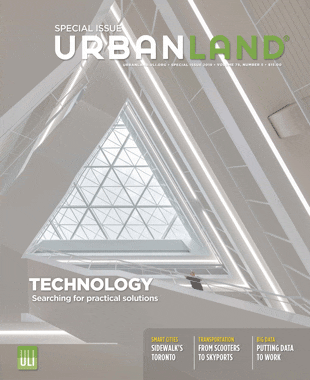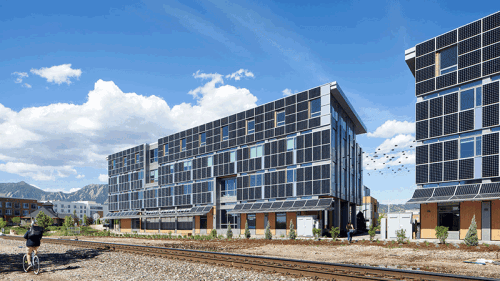This article appeared in the tech issue of Urban Land on page 17.
When technology is most useful, you quickly forget how much science, engineering, hardware, and software are involved in it. You focus instead on the service and convenience it offers; it becomes part of your routine. You assume, for example, that an Uber will be available to take you home at odd hours, and even from odd locations. We don’t tend to ponder the cellphone towers, satellite-enabled GPS, computer servers, or miniaturized phone circuitry that allow such wizardry.
Even when a technology is useful, it often carries unintended consequences. Take, for example, the doorbell camera I recently installed at home. It’s handy to be able to see a visitor at the door when I’m not there, especially because I can speak with him through my mobile phone and he’s not certain whether I am out of town or on the couch. When we’re on the road and my dog hears the doorbell jingle through my phone, he can bark at the mailman from afar. That’s an unexpected benefit for him.
But the technology carries unintended consequences: neighbors passing by on the sidewalk, who did not sign up for surveillance, are recorded on video that’s uploaded to the internet. In some cases—usually with the doorbell owner’s consent, but not always—such videos are shared with local police as a matter of course. (I have not volunteered to share my front door video with anyone.) Whether such sharing is desirable is something each person must wrestle with. And communities face the delicate task of balancing privacy with public safety.
Which emerging real estate technologies will become the must-haves, and which will be the near misses? You can take your chances on a $100 doorbell, but if you are investing millions in a property or trying to run a profitable business, you cannot afford to waste resources on fads. Those two questions—what are the unintended consequences, and which technologies have staying power—are themes running throughout this special issue of Urban Land.
With the establishment of new technology product councils in Europe and the Asia Pacific region, in addition to the Technology and Real Estate Council in the Americas that launched in 2018, we have the opportunity to hear the views of leading ULI members from around the world regarding a single, though broad, topic. This roundtable conversation, “Outlook for Property Technology,” begins on page 32. Council leaders share how they keep their eyes on the bottom line when evaluating new technologies—and the promises being pitched to them.
Former ULI chief executive officer Patrick L. Phillips offers his insights on the mightily ambitious plans proposed by Sidewalk Labs (a sister company of Google) for the waterfront in Toronto. Technology is embedded throughout the plans, but so are principles of sound urban planning. Coverage of the plans put forth by Sidewalk Labs begins on page 46 with the article, “The Smarter City.”
And, in this issue, we offer a new editorial feature: “Tech Takeaways.” Over seven pages, we offer snippets of tech-related information discussed at the ULI Fall Meeting in Washington, D.C., along with additional reporting. It’s an easy read covering a lot of ground.
And, finally, on page 84, tech writer Rob Pegoraro reports on the practicalities of bringing 5G wireless technology into large structures. His bottom line: there won’t be much payoff to being an early adopter.
Watch for the next issue of Urban Land to arrive early in the new year. It will cover financial and economic trends for the coming year, including a comprehensive look at the Emerging Trends in Real Estate® 2020 reports for Europe, Asia Pacific, and the Americas. We also will have a fresh report on Opportunity Zones in the United States. Best wishes to you for the remainder of 2019.



